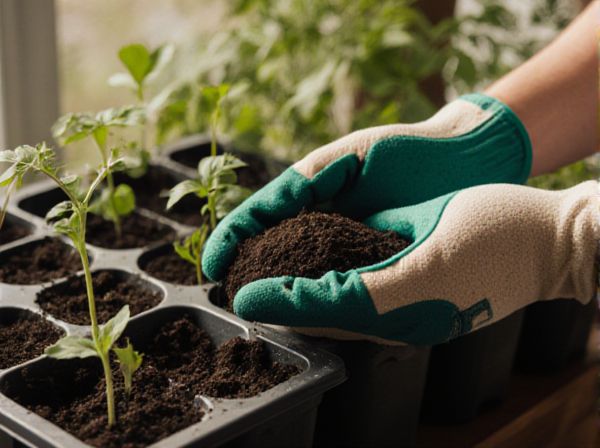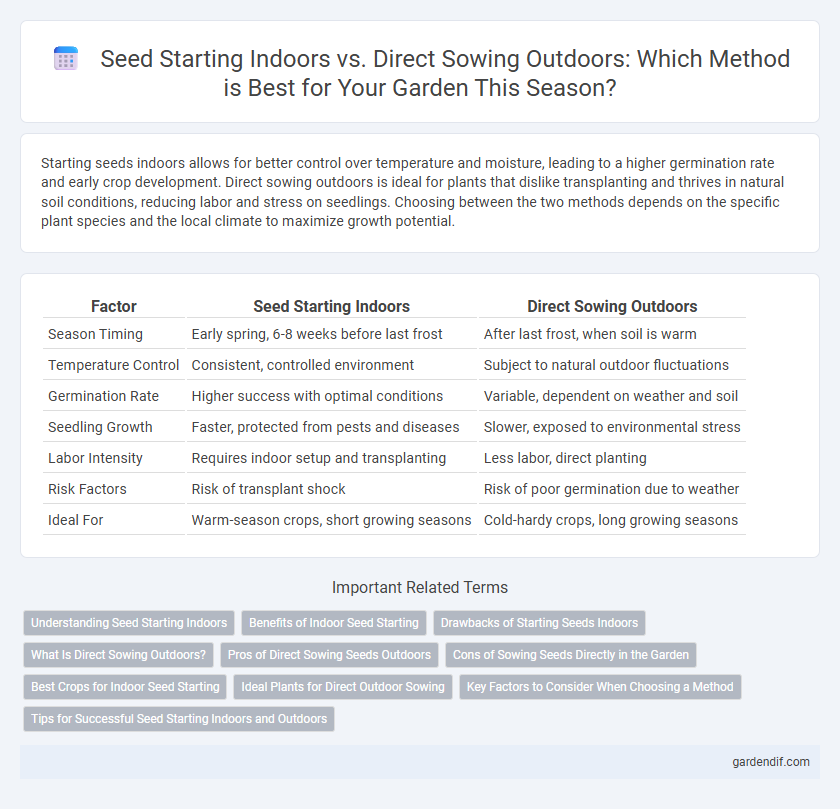
Seed starting indoors vs Direct sowing outdoors Illustration
Starting seeds indoors allows for better control over temperature and moisture, leading to a higher germination rate and early crop development. Direct sowing outdoors is ideal for plants that dislike transplanting and thrives in natural soil conditions, reducing labor and stress on seedlings. Choosing between the two methods depends on the specific plant species and the local climate to maximize growth potential.
Table of Comparison
| Factor | Seed Starting Indoors | Direct Sowing Outdoors |
|---|---|---|
| Season Timing | Early spring, 6-8 weeks before last frost | After last frost, when soil is warm |
| Temperature Control | Consistent, controlled environment | Subject to natural outdoor fluctuations |
| Germination Rate | Higher success with optimal conditions | Variable, dependent on weather and soil |
| Seedling Growth | Faster, protected from pests and diseases | Slower, exposed to environmental stress |
| Labor Intensity | Requires indoor setup and transplanting | Less labor, direct planting |
| Risk Factors | Risk of transplant shock | Risk of poor germination due to weather |
| Ideal For | Warm-season crops, short growing seasons | Cold-hardy crops, long growing seasons |
Understanding Seed Starting Indoors
Seed starting indoors allows gardeners to control temperature, light, and moisture for optimal germination, significantly increasing the success rate of seedlings. This method extends the growing season by giving plants a head start before outdoor conditions become favorable. Understanding the specific requirements for indoor seed starting, such as using sterile soil and providing adequate warmth, is essential for healthy and vigorous plant development.
Benefits of Indoor Seed Starting
Starting seeds indoors offers precise control over temperature, moisture, and light, accelerating germination rates and improving seedling quality. This method extends the growing season by allowing an early start before outdoor conditions are favorable, leading to stronger plants and higher yields. Indoor seed starting reduces the risk of pests, diseases, and harsh weather, ensuring better survival rates compared to direct sowing outdoors.
Drawbacks of Starting Seeds Indoors
Starting seeds indoors can lead to leggy, weak seedlings due to insufficient light intensity and improper air circulation. Transplant shock often occurs when moving indoor seedlings outdoors, delaying growth and reducing overall plant vigor. Indoor seed starting also requires controlled temperature and consistent watering, increasing labor and resource demands compared to direct sowing outdoors.
What Is Direct Sowing Outdoors?
Direct sowing outdoors involves planting seeds directly into the garden soil at the appropriate time for the specific crop and local climate conditions. This method allows seeds to germinate in their natural environment, promoting stronger root development and reducing transplant shock compared to starting seeds indoors. Gardeners prefer direct sowing for crops like carrots, beans, and peas that do not transplant well or have sensitive root systems.
Pros of Direct Sowing Seeds Outdoors
Direct sowing seeds outdoors leverages natural sunlight and consistent soil temperatures, promoting stronger root development and healthier plant growth. This method reduces transplant shock and labor costs associated with seedling care indoors. Exposing seeds directly to their natural environment encourages plants to adapt better to local conditions, enhancing their resilience and yield.
Cons of Sowing Seeds Directly in the Garden
Sowing seeds directly in the garden exposes young plants to unpredictable weather conditions and pest attacks, leading to lower germination rates and reduced crop yield. Soil temperature fluctuations and moisture inconsistency further hinder seed development, delaying growth compared to controlled indoor environments. Direct sowing also limits the growing season for certain plants, restricting gardeners from optimizing timing for maximum productivity.
Best Crops for Indoor Seed Starting
Tomatoes, peppers, and eggplants are the best crops for indoor seed starting due to their long growing seasons and need for warm soil. Herbs like basil and parsley also thrive when started indoors early, ensuring strong seedlings before transplanting. Leafy greens and root vegetables are typically better suited for direct sowing outdoors, as they mature quickly and prefer cooler soil temperatures.
Ideal Plants for Direct Outdoor Sowing
Certain vegetables and herbs thrive when sown directly outdoors due to their tolerance for cooler soil and less delicate germination needs. Peas, beans, carrots, radishes, and spinach perform best when planted directly in the garden as they establish strong root systems without transplant shock. Warm-season crops like cucumbers and zucchini also benefit from direct sowing after the last frost, ensuring healthy growth and higher yields.
Key Factors to Consider When Choosing a Method
Seed starting indoors offers controlled environment benefits such as consistent temperature, humidity, and protection from pests, which is ideal for early-season crops or delicate plants. Direct sowing outdoors depends on soil temperature, moisture levels, and frost dates, making it essential to choose the right timing for optimal germination and growth. Consider crop type, climate conditions, space availability, and desired harvest timeline when deciding between indoor seed starting and outdoor direct sowing.
Tips for Successful Seed Starting Indoors and Outdoors
For successful seed starting indoors, maintain consistent warmth between 65-75degF and use a quality seed-starting mix to promote germination, ensuring trays have proper drainage and light exposure from grow lights or sunny windows. When direct sowing outdoors, choose a planting site with well-drained soil, prepare the ground by loosening it and removing weeds, and sow seeds at the recommended depth according to packet instructions to avoid dry-out or frost damage. Water gently after planting to keep soil moist but not waterlogged, and thin seedlings as they grow to provide optimal space and airflow.
Seed starting indoors vs Direct sowing outdoors Infographic

 gardendif.com
gardendif.com